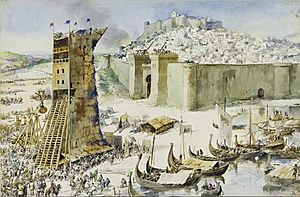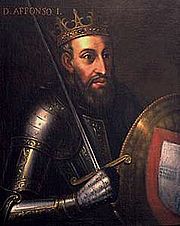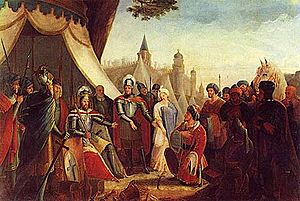Siege of Lisbon facts for kids
Quick facts for kids Siege of Lisbon |
|||||||
|---|---|---|---|---|---|---|---|
| Part of the Portuguese Reconquista and the Second Crusade |
|||||||
 The Conquest of Lisbon painting by Alfredo Roque Gameiro (1917) |
|||||||
|
|||||||
| Belligerents | |||||||
| Taifa of Badajoz | |||||||
| Commanders and leaders | |||||||
| Afonso I of Portugal Hervey de Glanvill Arnout IV, Count of Aarschot Christian of Ghistelles Simon of Dover Andrew of London Saher of Archelle William Longsword |
Muhammad ibn Hakam | ||||||
| Strength | |||||||
|
20,000
|
~15,000 | ||||||
The Siege of Lisbon was a big battle that happened from July 1 to October 25, 1147. It was when the Christian forces of the new Kingdom of Portugal took control of the city of Lisbon from its Muslim rulers.
This siege was one of the few successes for the Christians during the Second Crusade. It was a very important event in the larger Reconquista, which was a long period when Christian kingdoms in the Iberian Peninsula (modern-day Spain and Portugal) fought to take back land from Muslim control.
In 1144, a city called Edessa fell to Muslim forces. This led Pope Eugene III to call for a new crusade in 1145 and 1146. In the spring of 1147, the Pope said it was okay to have a crusade in the Iberian Peninsula too. He also allowed Alfonso VII of León and Castile to count his fights against the Moors (Muslims in Iberia) as part of the Second Crusade.
In May 1147, a group of crusaders left Dartmouth, Devon in England. They planned to sail all the way to the Holy Land (the Middle East). But bad weather forced their ships to stop in Porto, a city on the northern coast of Portugal, on June 16, 1147. There, they met Afonso I of Portugal, who had declared himself king of the new Kingdom of Portugal in 1139.
The crusaders agreed to help King Afonso attack Lisbon. They made a deal that the crusaders could take goods from the city and get money for any prisoners they captured. The siege started on July 1. Lisbon was a large city at the time, with many families, including people who had fled from nearby Christian attacks. The city eventually surrendered on October 24, mostly because the people inside were starving.
Most of the crusaders stayed in Lisbon after it was captured. But some continued their journey to the Holy Land. Lisbon later became the capital city of Portugal in 1255.
Contents
The Second Crusade's Impact
The Reconquista is often thought to have started around 722, after a battle called Battle of Covadonga. After the First Crusade (1095–1099), Pope Paschal II told crusaders in Iberia to stay and fight there. He said their battles were just as important as those fought in Jerusalem.
In 1142, King Afonso Henriques tried to take Lisbon with the help of some crusaders passing through. This attempt failed, but it showed the king how useful such forces could be in the future.
The fall of Edessa in 1144 led to a new call for a crusade by Pope Eugene III. In 1147, the Pope also approved a crusade in the Iberian Peninsula, where fighting against the Moors had been going on for hundreds of years. The Pope encouraged cities like Marseilles and Genoa to help fight in Iberia.
On May 19, 1147, a group of crusaders left Dartmouth, England. These crusaders came from different places like Flanders, France, England, and Germany. There was no single king or prince leading them. Instead, they were mostly townsmen who had sworn an oath to each other. Their leaders included Hervey de Glanvill, Arnout IV, Count of Aarschot, and Christian of Gistel. Important decisions were made together by these commanders.
Crusaders Change Plans
There were many ships, possibly as many as 200, heading for the Holy Land. But bad weather forced them to stop in Porto, Portugal, on June 16, 1147. There, the bishop of Porto convinced them to meet with King Afonso. The king had just captured the city of Santarém and was eager to meet the crusaders.
The crusaders, who were a mix of different nationalities, agreed to help King Afonso. They made a formal agreement: the crusaders could take all the goods and ransom money from prisoners in Lisbon. After they had taken everything they wanted, they would hand the city over to the king.
King Afonso also promised to give parts of the captured land to the crusader leaders. He also said that those who fought in the siege, and their families, would not have to pay a special trading tax in Portugal.
At first, the English crusaders were not excited about changing their plans. But Hervey de Glanville convinced them to join. Some, however, refused because of an earlier failed attempt to capture Lisbon in 1142. To make sure everyone kept their promises, they exchanged hostages.
Lisbon Falls
The siege of Lisbon began on July 1. The Christian forces quickly took control of the areas around the city and then surrounded Lisbon's walls. After four months, the city's leaders agreed to surrender on October 21. This was because a crusader siege tower reached their wall, and the people inside the city were starving. Many people from other towns had also sought safety in Lisbon, making the food shortage worse.
After some fighting and disorder inside the city, the Christian conquerors entered Lisbon on October 25. The original surrender terms said that the Muslim soldiers and citizens could keep their lives and property. However, these terms were not fully kept once the Christians entered the city.
What Happened Next
Some of the crusaders continued their journey around the Iberian Peninsula. They were invited by Ramon Berenguer IV, Count of Barcelona to help him capture the city of Tortosa. However, most of the crusaders stayed in Lisbon. This helped increase the number of Christian supporters in Portugal.
Gilbert of Hastings was chosen to be the new bishop of Lisbon. This marked the start of a long friendship between England and Portugal, which later became known as the Anglo-Portuguese Alliance.
There is a legend that a Portuguese warrior named Martim Moniz sacrificed himself to keep the city gates open for the Christian armies.
Lisbon officially became the capital city of the Kingdom of Portugal in 1255. The victory was a major turning point in the history of Portugal and the wider Reconquista, which finally ended in 1492.
See also
 In Spanish: Toma de Lisboa (1147) para niños
In Spanish: Toma de Lisboa (1147) para niños
- Saint George's Castle
- Portugal in the Middle Ages
- Timeline of Portuguese history
- De expugnatione Lyxbonensi, a firsthand account from the time.
Sources
- Villegas-Aristizábal, Lucas, "Norman and Anglo-Norman Participation in the Iberian Reconquista", Ph.D Thesis, Nottingham, 2007, pp. 146–85.
- Villegas-Aristizábal, Lucas, "Revisiting the Anglo-Norman Crusaders' Failed Attempt to Conquer Lisbon c. 1142", Portuguese Studies 29:1 (2013), pp. 7–20.
- West, Charles (2013), "All in the same boat? East Anglia, the North Sea world and the 1147 expedition to Lisbon", in D. Bates and R. Liddiard (eds.) East Anglia and its North Sea World in the Middle Ages, pp. 287–300, ISBN: 9781843838463



